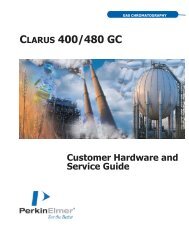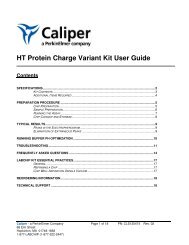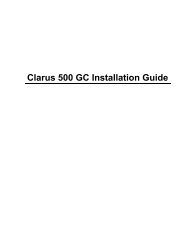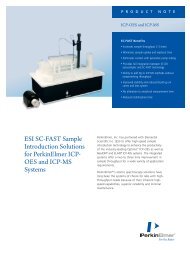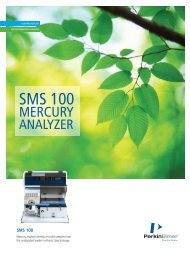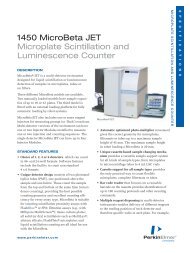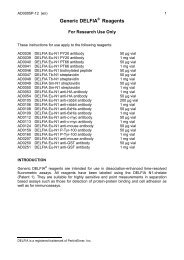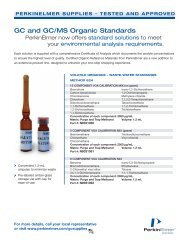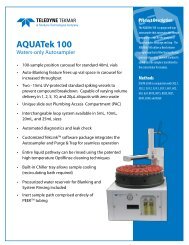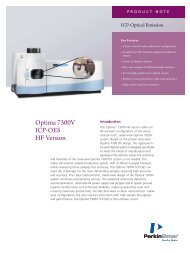Comparison of LANCE Ultra TR-FRET to PerkinElmer's Classical ...
Comparison of LANCE Ultra TR-FRET to PerkinElmer's Classical ...
Comparison of LANCE Ultra TR-FRET to PerkinElmer's Classical ...
You also want an ePaper? Increase the reach of your titles
YUMPU automatically turns print PDFs into web optimized ePapers that Google loves.
<strong>Comparison</strong> <strong>of</strong> <strong>LANCE</strong> <strong>Ultra</strong><br />
<strong>TR</strong>-<strong>FRET</strong> <strong>to</strong> PerkinElmer’s<br />
<strong>Classical</strong> <strong>LANCE</strong> <strong>TR</strong>-<strong>FRET</strong><br />
Platform for Kinase Applications<br />
<strong>LANCE</strong> UL<strong>TR</strong>A <strong>TR</strong>-<strong>FRET</strong> TECHNOLOGY<br />
A P P L I C A T I O N N O T E<br />
Introduction<br />
Protein kinases play a major role<br />
in normal cellular functions such<br />
as cell proliferation, angiogenesis,<br />
and cell adhesion. Dysregulation<br />
<strong>of</strong> kinase activity has been shown<br />
<strong>to</strong> be associated with several<br />
human diseases including cancer,<br />
diabetes and morphological<br />
disorders. This makes kinases<br />
crucial targets for the discovery<br />
and development <strong>of</strong> new drugs.<br />
Analysis <strong>of</strong> the human genome<br />
has revealed the existence <strong>of</strong><br />
nearly 520 genes encoding<br />
kinases. The abundance <strong>of</strong> these<br />
potential therapeutic targets<br />
provides a compelling impetus<br />
for developing efficient and<br />
robust high-throughput screening<br />
(HTS) assay platforms for the<br />
discovery <strong>of</strong> kinase modula<strong>to</strong>rs.<br />
Time-resolved fluorescence<br />
resonance energy transfer (<strong>TR</strong>-<br />
<strong>FRET</strong>) assays are homogeneous<br />
proximity assays in which energy<br />
is transferred from a donor <strong>to</strong> an<br />
accep<strong>to</strong>r molecule. A number <strong>of</strong><br />
<strong>TR</strong>-<strong>FRET</strong> platforms are currently<br />
available that differ principally<br />
in the nature <strong>of</strong> the donor and<br />
accep<strong>to</strong>r dyes. The <strong>LANCE</strong> ®<br />
technology, for example, uses an<br />
europium chelate (Eu) as donor<br />
dye, which <strong>of</strong>fers a number <strong>of</strong><br />
advantages, including a high<br />
quantum yield, large S<strong>to</strong>kes’ shift<br />
and a narrow-banded emission at<br />
around 615 nm. Furthermore, the<br />
lifetime <strong>of</strong> emitted light from Eu<br />
chelate dyes is exceptionally<br />
long, allowing for time-delayed<br />
measurements. The unique<br />
fluorescence properties <strong>of</strong> Eu<br />
chelates make them ideal energy<br />
donors in <strong>TR</strong>-<strong>FRET</strong> assays.<br />
In classical <strong>LANCE</strong> assays the<br />
accep<strong>to</strong>r dye is allophycocyanin<br />
(APC). APC receives the energy<br />
from irradiated Eu chelate molecules<br />
in close proximity, and in<br />
turn emits light at 665 nm.<br />
Although APC allows for the<br />
efficient capture and re-emission<br />
<strong>of</strong> the transferred energy, there<br />
are some disadvantages. APC<br />
is a bulky and light-sensitive<br />
protein prone <strong>to</strong> generating<br />
potential steric hindrances in<br />
some assay configurations.<br />
Authors<br />
Mireille Legault, Philippe Roby,<br />
Lucille Beaudet and<br />
Nathalie Rouleau<br />
PerkinElmer Life and<br />
Analytical Sciences<br />
www.perkinelmer.com
<strong>LANCE</strong> <strong>Ultra</strong><br />
(ULight-poly-GT-based)<br />
<strong>LANCE</strong> <strong>Ultra</strong><br />
(ULight-streptavidin-based)<br />
<strong>Classical</strong> <strong>LANCE</strong><br />
(APC-streptavidin-based)<br />
Accep<strong>to</strong>r:<br />
ULight<br />
Accep<strong>to</strong>r:<br />
ULight<br />
Accep<strong>to</strong>r:<br />
Allophycocyanin (APC)<br />
Figure 1. Schematic representation <strong>of</strong> <strong>LANCE</strong> <strong>Ultra</strong> and <strong>LANCE</strong> for Src kinase assays. Following Src kinase reactions, labeled phospho-poly-GT<br />
is detected using three different <strong>LANCE</strong> assay formats. A) Poly-GT is labeled with the small ULight dye. B) Poly-GT is biotinylated and captured by<br />
ULight-labeled streptavidin. C) Poly-GT is biotinylated and captured by APC-SA. In all three assays, the phosphorylated amino acid is recognized<br />
by an anti-phospho-tyrosine antibody (PY20) labeled with Eu. Upon excitation <strong>of</strong> the Eu-labeled antibody, energy is transferred <strong>to</strong> the accep<strong>to</strong>r dye<br />
resulting in emission <strong>of</strong> light at 665 nm.<br />
In addition, small molecules such<br />
as peptides and oligonucleotides<br />
cannot be labeled directly with<br />
APC, resulting in the need <strong>to</strong> use a<br />
biotinylated substrate combined<br />
with APC-streptavidin (APC-SA).<br />
To overcome these limitations,<br />
PerkinElmer has developed the new<br />
<strong>LANCE</strong> <strong>Ultra</strong> HTS platform in<br />
which the APC accep<strong>to</strong>r dye has<br />
been replaced by a new ULight<br />
accep<strong>to</strong>r dye (Figure 1).<br />
ULight is a small, light resistant<br />
accep<strong>to</strong>r dye with spectral characteristics<br />
similar <strong>to</strong> APC. Its redshifted<br />
emission is less sensitive <strong>to</strong><br />
quenching by colored compounds,<br />
which eliminates the need for<br />
ratiometric data analysis.<br />
Importantly, the ULight dye’s low<br />
molecular weight allows direct<br />
labeling <strong>of</strong> molecules <strong>of</strong> any size.<br />
In kinase assays, the dye can be<br />
coupled directly <strong>to</strong> kinase substrates<br />
or <strong>to</strong> streptavidin for the<br />
capture <strong>of</strong> biotinylated substrates.<br />
This application note presents a<br />
comparison <strong>of</strong> <strong>LANCE</strong> <strong>Ultra</strong> with<br />
the classical <strong>LANCE</strong> platform.<br />
The development <strong>of</strong> a Src tyrosine<br />
kinase assay measuring the phosphorylation<br />
<strong>of</strong> a poly Glu-Tyr<br />
(poly-GT) substrate was used<br />
as a model system.<br />
Materials and Methods<br />
Materials<br />
Table 1 lists the materials used<br />
for this study, including suppliers<br />
and product numbers.<br />
2
Table 1. Reagents and Consumables<br />
Item Supplier Product No.<br />
ULight-poly-GT PerkinElmer <strong>TR</strong>F0100-M<br />
ULight-Streptavidin PerkinElmer <strong>TR</strong>F0102-M<br />
SureLight Allophycocyanin-Streptavidin PerkinElmer CR130-100<br />
Biotinylated-poly-GT PerkinElmer Cus<strong>to</strong>m product<br />
<strong>LANCE</strong> Eu-PY20 Antibody PerkinElmer AD0066<br />
<strong>LANCE</strong> Detection Buffer 10X PerkinElmer CR97-100<br />
Src Kinase, active Millipore Corp. 14-326<br />
ATP (adenosine 5'-triphosphate disodium salt) Sigma-Aldrich, Inc. A2383<br />
Staurosporine Sigma-Aldrich, Inc. S4400<br />
White OptiPlate-384 PerkinElmer 6007290<br />
TopSeal-A PerkinElmer 6005250<br />
EnVision Multilabel Reader PerkinElmer 2102-0010<br />
Excitation Filter UV2(<strong>TR</strong>F) 320 nm PerkinElmer 2100-5060<br />
Mirror <strong>LANCE</strong>/DELFIA Dual PerkinElmer 2100-4160<br />
Emission Filter: Eu 615 nm PerkinElmer 2100-5090<br />
Emission Filter: <strong>LANCE</strong> 665 nm PerkinElmer 2100-5110<br />
Src Kinase Buffer: 50 mM Tris-HCl, pH 7.5, 10 mM MgCl 2 ,<br />
1 mM EGTA, 2 mM DTT and 0.01% Tween-20<br />
Kinase Assays<br />
Assay conditions were optimized<br />
independently for each <strong>of</strong> the three<br />
<strong>TR</strong>-<strong>FRET</strong> platforms. All concentrations<br />
listed below are final concentrations<br />
in either the kinase or<br />
detection reaction. <strong>LANCE</strong> <strong>Ultra</strong><br />
and classical <strong>LANCE</strong> signals were<br />
detected using the same settings on<br />
the EnVision Multilabel Reader<br />
(excitation at 320 nm and emission<br />
at 665 nm).<br />
<strong>LANCE</strong> <strong>Ultra</strong> (ULight-poly-GT)<br />
Optimized conditions consisted <strong>of</strong><br />
1 nM Src, 100 nM ULight-poly-GT<br />
and ATP at the EC 50 value. Assay<br />
components were diluted in<br />
Kinase Buffer and added <strong>to</strong> a white<br />
OptiPlate-384 in a final volume <strong>of</strong><br />
10 µL. Plates were incubated for 90<br />
min at room temperature (RT) and<br />
kinase reactions were s<strong>to</strong>pped by<br />
the addition <strong>of</strong> 10 mM EDTA. Five<br />
minutes after the addition <strong>of</strong> EDTA,<br />
2 nM <strong>of</strong> Eu-labeled PY20 antibody,<br />
diluted in detection buffer, was<br />
added for the detection <strong>of</strong> phosphoproducts.<br />
Reactions were incubated<br />
for 1 h at RT prior <strong>to</strong> signal reading.<br />
<strong>LANCE</strong> <strong>Ultra</strong> (ULight-Streptavidin;<br />
biotinylated poly-GT)<br />
Kinase reactions were performed as<br />
described for the ULight-poly-GT<br />
assay. Five minutes after the<br />
addition <strong>of</strong> EDTA, Eu-labeled<br />
PY20 (2 nM) antibody and ULight-<br />
Streptavidin (ULight-SA; 100 nM),<br />
diluted in Detection Buffer, were<br />
added for the detection <strong>of</strong> phosphoproducts.<br />
Reactions were incubated<br />
for 1 h at RT prior <strong>to</strong> signal reading.<br />
<strong>Classical</strong> <strong>LANCE</strong> (APC-<br />
Streptavidin; biotinylated poly-GT)<br />
Kinase reactions were performed as<br />
described for the ULight-poly-GT<br />
assay. Five minutes after the<br />
addition <strong>of</strong> EDTA, Eu-labeled PY20<br />
(2 nM) antibody and APC-SA (APC-<br />
SA; 100 nM), diluted in Detection<br />
Buffer, were added for the detection<br />
<strong>of</strong> phospho-products. Reactions<br />
were incubated for 1 h at RT prior<br />
<strong>to</strong> signal reading.<br />
Results<br />
Assay Optimization<br />
Assay optimization was performed<br />
in order <strong>to</strong> compare <strong>LANCE</strong> <strong>Ultra</strong><br />
and classical <strong>LANCE</strong> assay formats.<br />
To determine the substrate concentration<br />
resulting in the best signal<br />
window, as well as <strong>to</strong> establish EC 50<br />
values, poly-GT was titrated. EC 50<br />
values in the low nanomolar range<br />
(0.6 nM <strong>to</strong> 4.7 nM) were obtained<br />
for all assay formats (Figure 2).<br />
Moreover, a specific signal could be<br />
detected using substrate concentrations<br />
as low as 300 pM. Due <strong>to</strong><br />
saturation <strong>of</strong> the labeled streptavidin,<br />
a hook effect was observed at<br />
100 nM substrate concentration in<br />
both the <strong>LANCE</strong> ULight-SA and the<br />
classical <strong>LANCE</strong> formats. For all<br />
assays, maximal signal window was<br />
generated at 100 nM poly-GT and<br />
this substrate concentration was<br />
used in all other experiments.
Figure 2. Poly-GT substrate titration. Dilutions <strong>of</strong> poly-GT substrate ranging from 10 pM <strong>to</strong> 1 µM were incubated with Src kinase (4 nM), ATP (20 µM),<br />
and A) ULight-poly-GT, or B) and C) biotin-poly-GT.<br />
A Src enzyme titration was performed. Figure 3 shows that similar EC 50 values were obtained in all three assays<br />
(ULight-poly-GT: 73 pM; ULight-SA: 37 pM; APC-SA: 65 pM). To limit assay variability and maximize the signal<br />
window, 1 nM Src kinase (a concentration in the assay plateau) was used for subsequent experiments.<br />
Figure 3. Enzyme titration. Dilutions <strong>of</strong> Src ranging from 0.3 pM <strong>to</strong> 30 nM were incubated with ATP (20 µM) and A) ULight-poly-GT (100 nM),<br />
or B) and C) biotin-poly-GT (100 nM).<br />
In screening campaigns, the identification <strong>of</strong> ATP competitive inhibi<strong>to</strong>rs requires the use <strong>of</strong> ATP concentrations at or<br />
near the K m value. ATP titration curves were performed <strong>to</strong> obtain EC 50 values that were considered <strong>to</strong> be the apparent<br />
K m values <strong>of</strong> the enzyme for ATP. Figure 4 shows similar values ranging from 250 <strong>to</strong> 500 nM for the three assays.<br />
Figure 4. ATP titration. Dilutions <strong>of</strong> ATP ranging from 1 nM <strong>to</strong> 100 µM were incubated with Src kinase (1 nM) and A) ULight-poly-GT (100 nM),<br />
or B) and C) biotin-poly-GT (100 nM).<br />
www.perkinelmer.com<br />
4
Evaluation <strong>of</strong> assay performance<br />
Staurosporine is a broad spectrum kinase inhibi<strong>to</strong>r competing for ATP binding. Staurosporine inhibition <strong>of</strong> the Src<br />
enzyme was evaluated <strong>to</strong> compare the performance <strong>of</strong> the three optimized <strong>LANCE</strong> assay formats. Competition curves<br />
performed at the apparent K m for ATP show that the three <strong>TR</strong>-<strong>FRET</strong> platforms give virtually identical IC 50 values for<br />
staurosporine (ULight-poly-GT: 19 nM; ULight-SA: 26 nM; APC-SA: 46 nM). These values are all within one log <strong>of</strong><br />
published IC 50 values for a staurosporine inhibition <strong>of</strong> Src 1 .<br />
Figure 5. Staurosporine inhibition curves. Dilutions <strong>of</strong> staurosporine ranging from 100 pM <strong>to</strong> 10 µM were pre-incubated for 10 min at RT using<br />
optimized Src and substrate conditions. ATP concentrations at the EC 50 value were used: A) 400 nM, B) 300 nM, and C) 500 nM.<br />
The robustness <strong>of</strong> the three assay platforms was assessed by determining the Z'-fac<strong>to</strong>r 2 in the presence or absence <strong>of</strong><br />
10 µM staurosporine (Figure 6). Assays were performed using ATP concentrations at the apparent K m . Reaction mixtures<br />
with or without staurosporine were dispensed in<strong>to</strong> 24 wells <strong>of</strong> a 384-well OptiPlate. Z'-fac<strong>to</strong>rs <strong>of</strong> 0.87 and 0.85<br />
were obtained for the <strong>LANCE</strong> <strong>Ultra</strong> ULight-poly-GT and ULight-Streptavidin containing reactions, respectively. The Z'-<br />
fac<strong>to</strong>r calculated for the classical <strong>LANCE</strong> assay was similar, with a value <strong>of</strong> 0.85.<br />
Figure 6. Z'-fac<strong>to</strong>r determination for the Src kinase assay. Optimized enzyme and substrate concentrations were used. ATP was added at the<br />
EC 50 value. Kinase reactions were performed in the absence (24 wells) or presence <strong>of</strong> 10 µM staurosporine (24 wells).<br />
www.perkinelmer.com<br />
5
Discussion<br />
This application note describes the<br />
optimization <strong>of</strong> an HTS Src kinase<br />
assay using PerkinElmer’s <strong>LANCE</strong><br />
<strong>Ultra</strong> and classical <strong>LANCE</strong> platforms.<br />
When compared <strong>to</strong> classical<br />
<strong>LANCE</strong>, the new <strong>LANCE</strong> <strong>Ultra</strong><br />
assays give similar EC 50 values for<br />
the substrate, enzyme, and ATP.<br />
Additionally, the results obtained<br />
from the staurosporine inhibition<br />
curves and Z'-fac<strong>to</strong>r determinations<br />
illustrate the robust performance<br />
and HTS suitability <strong>of</strong> both<br />
<strong>LANCE</strong> <strong>Ultra</strong> assay formats.<br />
References<br />
1. Sigma Aldrich. .<br />
2. Zhang, J.H., Chung, T.D.Y.,<br />
Oldenburg, K.R. 1999. A simple<br />
statistical parameter for use in<br />
evaluation and validation <strong>of</strong> high<br />
throughput screening assays. J.<br />
Biomol. Screen. 4:67-73.<br />
The power <strong>of</strong> <strong>LANCE</strong> <strong>Ultra</strong><br />
comes from the combination <strong>of</strong><br />
PerkinElmer’s Eu chelate donor dye<br />
and new ULight accep<strong>to</strong>r dye. The<br />
ULight dye <strong>of</strong>fers distinct advantages<br />
over APC. It is light resistant<br />
and its small size allows for the<br />
direct labeling <strong>of</strong> molecules <strong>of</strong> any<br />
size. Moreover, the possibility <strong>of</strong><br />
directly labeling kinase substrates<br />
with the ULight dye will greatly<br />
simplify assay development. For<br />
cases where a biotinylated substrate<br />
is preferred, the use <strong>of</strong> ULight-SA<br />
provides an ideal alternative.<br />
PerkinElmer Life and<br />
Analytical Sciences<br />
710 Bridgeport Avenue<br />
Shel<strong>to</strong>n, CT 06484-4794 USA<br />
Phone: (800) 762-4000 or<br />
(+1) 203-925-4602<br />
www.perkinelmer.com<br />
For a complete listing <strong>of</strong> our global <strong>of</strong>fices, visit www.perkinelmer.com/las<strong>of</strong>fices<br />
©2006 PerkinElmer, Inc. All rights reserved. The PerkinElmer logo and design are registered trademarks <strong>of</strong> PerkinElmer, Inc. <strong>LANCE</strong> is a registered trademark and DELFIA, EnVision,<br />
OptiPlate, SureLight, TopSeal-A and ULight are trademarks <strong>of</strong> PerkinElmer, Inc. or its subsidiaries, in the United States and other countries. ULight is covered under patent numbers<br />
US20050202565 and US20040166515. All other trademarks not owned by PerkinElmer, Inc. or its subsidiaries that are depicted herein are the property <strong>of</strong> their respective owners.<br />
PerkinElmer reserves the right <strong>to</strong> change this document at any time without notice and disclaims liability for edi<strong>to</strong>rial, pic<strong>to</strong>rial or typographical errors.<br />
007755_01 Printed in USA



